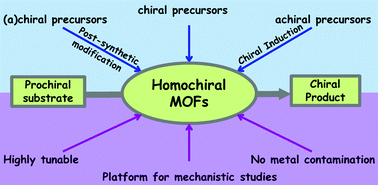Homochiral metal–organic frameworks as heterogeneous catalysts
Abstract
Homochiral metal–organic frameworks (HMOFs) are attractive materials for asymmetric catalysis because they possess high surface area and uniform active sites. A variety of catalytic applications reported so far indicate that HMOFs catalyse a range of transformations, including cyanosilylation, aldol condensation and hydrogenation reactions. Besides contribution to fundamental knowledge, it is also important to evaluate the relevance of organic transformations catalysed by HMOFs and how existing achievements compare with already established enantioselective catalysts. This mini-review gives an overview of the structural design and the catalytic performance of HMOFs and it focuses on the relevance of the chemical reactions tested. It aims at combining the existing demand for heterogeneous asymmetric catalysts with the current knowledge on HMOFs. This is important for the MOF community since it highlights relevant broad scope asymmetric catalytic transformations performed in industry and the insight gained from the catalytic reactions carried out using HMOFs as catalysts. We hope that this work will motivate researchers to rationally design HMOFs with a goal to unveil reaction mechanisms and the interactions between the HMOFs and the reaction molecules for industrially relevant catalytic reactions.

- This article is part of the themed collection: 2018 Inorganic Chemistry Frontiers Review-type Articles


 Please wait while we load your content...
Please wait while we load your content...